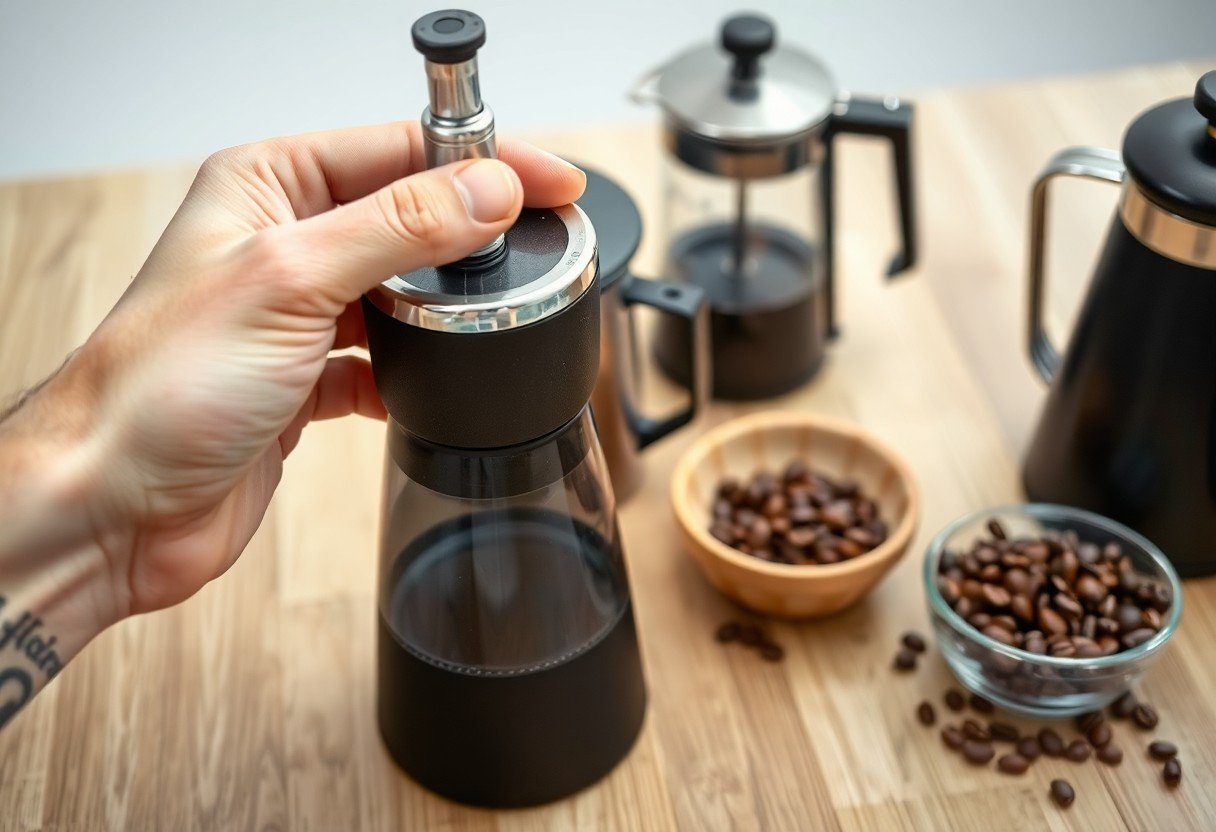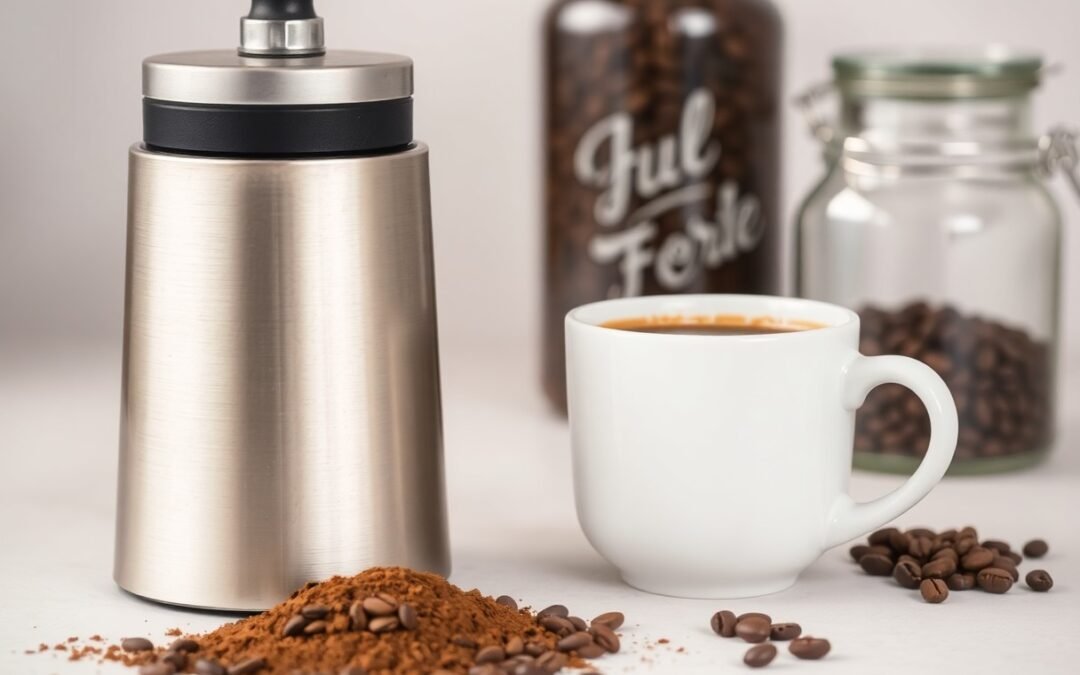It’s widely recognized that the freshness of your coffee beans significantly impacts the flavor and aroma of your brew. When you grind your coffee just before brewing, you unlock necessary oils and compounds that contribute to a richer, more sophisticated cup. By investing in a quality grinder and adopting this simple practice, you can elevate your coffee experience at home, ensuring every sip is filled with vibrant taste and complexity. Your morning routine can transform into an indulgent ritual that delights your senses and enhances your appreciation for this beloved beverage.

The Flavor Revolution: Why Freshly Ground Coffee Matters
A cup of coffee is transformed when you grind the beans fresh. The moment you break the coffee bean’s structure, an array of aromatic compounds and oils are released, leading to a depth of flavor that pre-ground options simply cannot match. By grinding just before brewing, you unlock the peak of your coffee’s flavor profile, ensuring each sip is vibrant and full-bodied. This simple act not only enhances taste but elevates your entire coffee-drinking experience at home.
Unpacking the Difference: Pre-Ground vs. Freshly Ground
Pre-ground coffee loses its flavor and aroma quickly due to oxidation. When you select freshly ground beans, you control the grind size to match your brew method, enhancing your coffee’s overall extraction. For instance, espresso requires a finer grind compared to a coarse French press. The control you gain by grinding at home allows you to tailor each cup to your specific preferences, resulting in a far superior flavor profile.
The Role of Flavor Compounds in Coffee Freshness
Flavor compounds such as lipids, acids, and sugars contribute to coffee’s complexity and richness. Freshly ground coffee retains these volatile substances longer, leading to a more pronounced taste. Over time, pre-ground coffee loses these flavor compounds, resulting in a flat and dull cup. Understanding this helps you appreciate the superior quality of freshly ground beans, as they deliver a harmonious balance of flavors that evolve with each sip.
Once coffee beans are ground, the surface area increases, allowing volatile aromatic compounds to escape rapidly. For example, studies show that around 60% of the flavorful compounds can dissipate within minutes after grinding. Each compound plays a role in your coffee’s aroma and taste, from fruity and floral notes to deeper chocolate undertones. This complexity can only be fully realized when you grind coffee just before brewing, ensuring that the lively nuances inherent in your beans are still intact, creating a far more sophisticated cup.
Grinding Techniques: Find Your Perfect Method
Discovering the right grinding technique transforms your brewing experience, allowing you to tailor your coffee to your taste. Experiment with methods such as manual hand grinders, electric grinders, or burr grinders to find what feels natural and fits your lifestyle. Each technique offers distinct benefits, influencing how your beans release their flavors during brewing. You might prefer the consistency of burr grinding or the portability of a manual grinder; the key is to find what suits your routine and savor every cup.
Understanding Grind Sizes: From Coarse to Fine
Grind size plays a pivotal role in the flavor profile of your coffee. Coarse grinds work best for methods like French press, where water interacts longer with the grounds, while fine grinds are ideal for espresso and AeroPress, demanding quick extraction for optimal taste. Experimenting with different grind sizes allows you to fine-tune your brew and achieve the desired strength and flavor complexity in each cup.
Essential Gear: Tools for the Home Barista
Your home coffee setup requires specific tools to enhance your grinding process and overall brewing quality. Starting with a reliable grinder, whether a quality burr or a hand grinder, ensures consistency in your grind size. You’ll also need a scale for precise measurements, and a brewing device tailored to your preferred method—like a French press, Chemex, or espresso machine. Don’t underestimate the importance of a good kettle, as controlling water temperature is vital for optimal extraction.
Investing in good-quality gear elevates your coffee-making experience. A burr grinder provides uniform grounds, enhancing the extraction process, while a digital scale ensures accurate measurements for consistent strength. For brewing, options like a Chemex offer elegant aesthetics while also promoting flavor clarity, making each cup a pleasure to savor. Prioritize tools that meet your specific brewing methods—this precision not only enhances taste but also transforms your home into a dedicated coffee haven.
Timing is Everything: The Optimal Grind Schedule
Maximizing flavor in your coffee hinges on implementing the right grind schedule. Ideally, you should grind your beans immediately before brewing to capture the most vibrant aromas and flavors. Delaying this step can lead to dull, flat coffee experiences, as volatile compounds quickly dissipate after grinding. Create a routine that aligns grinding with your brewing actions—this way, each cup remains at peak freshness and complexity, transforming your daily ritual into a moment of pure indulgence.
How Long Can Coffee Last After Grinding?
Once coffee is ground, it reaches its peak freshness within the first 15 minutes, as vital oils and aromatic compounds begin to degrade. After that, its flavor profile diminishes rapidly. Stored properly, ground coffee can retain some flavor for up to a week, but after that, you are likely brewing a subpar cup. The best practice is to grind only as much as you need for each session to ensure maximum flavor and aroma in your brew.
The Importance of Grind Just Before Brewing
Grinding right before brewing allows you to harness the full bouquet of flavors locked within each coffee bean. The moment coffee is ground, its vital oils and compounds begin to evaporate, leading to a loss in aromatic intensity and taste complexity. To illustrate this, consider the difference between using pre-ground coffee, which has often sat on the shelf for weeks, versus a fresh grind; the latter can provide a cup with nuanced notes, deeper richness, and a more satisfying mouthfeel. By integrating this practice into your routine, you’re not just brewing coffee, but crafting a captivating sensory experience that elevates your daily ritual.

Elevating Your Brew: Pairing Grinding with Brewing Methods
The grind size of your coffee plays a pivotal role in how the flavors develop during brewing. Tailoring your grind to suit your chosen method transforms your coffee experience, unlocking new dimensions of taste. A coarse grind enhances cold brew’s mellow profile, while a fine grind perfects espresso’s bold intensity. By aligning the grind size with your brewing technique, you elevate not just the flavor, but the entire brewing ritual, allowing for a tailored cup that reflects your personal preferences.
Matchmaking Grind Size to Brewing Technique
Your grinding strategy should mirror the specific brewing method you’ve selected. For instance, a French press calls for a coarse grind to prevent over-extraction, resulting in a smooth cup. Conversely, a pour-over benefits from a medium grind, fostering an even extraction and balanced flavor. Adjusting the grind size for methods like AeroPress or siphon can dramatically alter your coffee’s taste profile, providing a customized experience that highlights the beans’ unique characteristics.
Cultivating Consistency: The Art of Adjusting Variables
To achieve that perfect cup, focus on consistency in your grinding technique. Variability in grind size can lead to uneven extraction, causing some flavors to overpower others. Using a high-quality burr grinder ensures uniformity, allowing you to experiment with factors like brew time and water temperature without compromising flavor. Small adjustments, such as slightly tweaking the grind size or brew time, can lead to a remarkable difference, refining your method and honing your palate.
Fine-tuning each factor in your brewing process opens opportunities for discovery. Consider experimenting with different grind settings while keeping other variables constant, such as water temperature and brew time. For example, adjusting your grind by just a few clicks on a burr grinder impacts extraction rates. A coarser grind may reduce bitterness, while a finer consistency can enhance bold flavors. Keeping detailed notes on your adjustments and their results will help you identify your ideal brewing parameters, ultimately guiding you toward a more sophisticated, personalized cup of coffee.
Common Missteps: What to Avoid in Grinding
Many enthusiasts fall into traps that compromise their coffee experience. Using dull blades or choosing the wrong grind size for your brewing method can drastically alter flavor profiles. Inconsistent grind sizes can lead to uneven extraction, resulting in bitter or underwhelming cups. Being aware of these common missteps enables you to optimize your grinding process, ensuring a more refined coffee at home.
Overlooking the Impact of Burr vs. Blade Grinders
The choice between burr and blade grinders significantly affects your coffee quality. Burr grinders produce a uniform grind size and allow for precise adjustments, resulting in more consistent extraction. Blade grinders, on the other hand, create uneven particle sizes leading to over-extraction of some coffee grounds and under-extraction of others, diminishing flavor complexity. Investing in a quality burr grinder can elevate your coffee experience.
The Dangers of Grinding Too Much or Too Little
Finding the right balance in the grind size is important for the optimal extraction of flavors. Grinding too fine can lead to over-extraction, creating a bitter taste, while too coarse may result in under-extraction, leaving your coffee flat and weak. Experimenting with your grind size according to your brewing method will yield the best results, ensuring a well-rounded and flavorful cup.
For example, espresso requires a finer grind to achieve the right pressure during brewing, while French press benefits from a coarser texture. Start with small adjustments; even a slight change in grind size can dramatically alter your cup’s taste. Keep track of your experiments to identify precise adjustments that enhance or diminish flavors. Understanding this delicate balance empowers you to elevate your coffee brewing game at home.
Final Words
Summing up, fresh grinding your coffee beans is key to unlocking the full potential of flavors and aromas in your cup. By controlling the grind size according to your brewing method, you enhance extraction, leading to a perfect balance of taste and richness that store-bought pre-ground coffee simply can’t match. Investing in a quality grinder allows you to enjoy barista-level sophistication right at home, transforming your daily coffee ritual into a truly elevated experience tailored to your preferences.
FAQ
Q: Why is fresh grinding important for coffee?
A: Fresh grinding releases the imperative oils and flavors in coffee beans, enhancing the taste and aroma of the brew, resulting in a more sophisticated cup.
Q: How does grind size affect the brewing process?
A: Different brewing methods require specific grind sizes to ensure optimal extraction. A uniform grind size contributes to a balanced flavor profile, preventing over-extraction or under-extraction.
Q: What type of grinder should I use for fresh grinding?
A: Burr grinders are recommended for fresh grinding because they provide a consistent grind size compared to blade grinders, which can result in uneven particle size and affect extraction.
Q: How can I tell if my coffee is freshly ground?
A: Freshly ground coffee will have a rich, aromatic scent and a slightly clumpy texture. It should appear slightly oily, indicating the oils have been released during grinding.
Q: How long does ground coffee retain its freshness?
A: Ground coffee begins to lose freshness within 15 minutes after grinding. For the best flavor, it’s ideal to brew coffee immediately after grinding.

